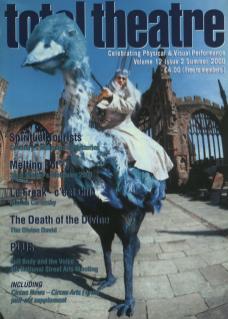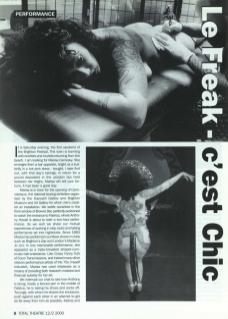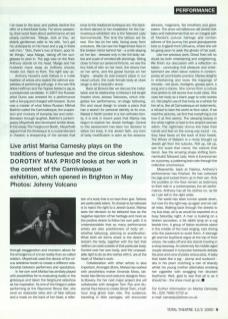It is Saturday evening, the first weekend of the Brighton Festival. The town is teeming with revellers and tourists returning from the beach. I am looking for Marisa Carnesky. She emerges from a bar opposite, bright as a butterfly in a hot pink dress – bought, I later find out, with that day's takings. In return for a pound deposited in the wooden box held between her thighs, Marisa will tell your fortune. It had been a good day.
Marisa is in town for the opening of Carnivalesque, the national touring exhibition organised by the Hayward Gallery and Brighton Museum and Art Gallery for which she's created an installation. We settle ourselves in the front window of Browns Bar, perfectly positioned to watch the entrance to Fabrica, where Anthony Howell is about to start a two-hour performance. As we wait we share our mutual experiences of working in strip clubs and taking performance art into nightclubs. Since 1993 Marisa has performed countless shows in clubs such as Brighton's Zap and London's Madame Jo Jo's. In one memorable performance, she appeared as a triple-breasted stripper-cum-music-hall-entertainer. Like Cosey Fanny lutti of Coum Transmissions, and indeed many other veteran performance artists of the 70s (myself included), Marisa has used striptease as a means of providing both research material and financial subsidy for her art.
We interrupt our chat to see how Anthony is doing. Inside a fenced pen in the middle of Fabrica, he is taking his shoes and socks off. Two pigs, with whom he shares the enclosure, push against each other in an attempt to get as far away from him as possible. Marisa and I sit close to the door, and politely decline the offer of a frankfurter butty. For some passers-by, their worst fears about performance art are clearly confirmed. 'Marge, look at this,' an elderly gentleman calls to his wife, 'he's got his underpants on his head and a pig in there with him.' 'Ooh, there's two of them, poor little things,' says Marge, taking off her sunglasses to peer in. The pigs wee on the floor. Anthony stands on his head. Marge and her husband move away as Anthony shouts: 'Inside out. Back to front. The right way up.’
Anthony Howell's work follows in a noble tradition of artists who exploit the satirical possibilities of performing with pigs. In the late 60s Abbie Hoffman and the Yippies fielded a pig as a presidential candidate. In 1907 the Russian artist Durov was arrested for a performance with a live pig and charged with treason. Durov was a master of what fellow Russian Mikhail Bakhtin called the Carnivalesque; the suspension and mockery of everyday law and order – liberation through laughter. Bakhtin's contemporary Meyerhold also developed similar ideas. In his essay ‘The Fairground Booth’, Meyerhold argued that the Grotesque is a crucial element in theatre; a sharpening of the senses that through exaggeration and inversion allows for the emergence of a truer reality than so-called realism. Meyerhold used the device of the circus sideshow booth to create a different relationship between performers and spectators.
In her own work Marisa has similarly played with possibilities for re-evaluating reality in the grotesque and taken the fairground sideshow as her inspiration. As one of the Dragon Ladies performing at the Raymond Revue Bar, she wore an elaborate latex skin of fake tattoos and a mask on the back of her head, a reference to the traditional burlesque act, the back-to-front dancer. In her installation for the Carnivalesque exhibition she is the Tattooed Lady Somnambulist. This time the tattoos are for real. She lies on her side, facing away from onlookers. We can see her fragmented face in the broken mirror behind her – a smile playing on her lips – dressed only in her full-body tattoo and a pair of wrinkled silk stockings. Sitting close to hear our personal fortune, we see the tiny folds of skin on her neck, the downy hair on her arms, and the goose bumps on her thighs – despite its ever-present place in our visual culture, the nude female body at close range is still a beautiful shock.
Back at Browns Bar we discuss the installation and its relationship to Marisa's full-length theatre show Jewess Tattooess, which integrates live performance, on-stage tattooing, film and visual design to create a piece that has a search for personal identity at its crux. Raised in North London in a non-orthodox family, it is only in recent years that Marisa has begun to explore her Jewish heritage. Central to this assessment has been her decision to tattoo her body. In the Jewish faith, any form of body modification is seen as the desecration of a body that is on loan from god. Tattoos are particularly taboo. To choose to be tattooed is to reject the right to a Jewish burial. Marisa sees her decision to be tattooed less as the negative rejection of her heritage and more as the positive desire to follow her own path. It is understandable that so many performance artists are also practitioners of body art – whether tattooing, piercing or scarification. What both artforms share is the desire to reclaim the body, together with the fact that neither can exist outside of that particular body. Control over her own body, and the unassailable right to do as she wishes with it, are at the heart of Marisa's work.
Collaboration with other artists is also important. Amongst others, Marisa has worked with prosthetics maker Amanda Moss, tattooist Alex Binnie and costume designer Nicola Bowery. For her next major project she will collaborate with designer Tom Pye and illusionist Paul Kieve to create Ghost Train, a half-hour long ghost train ride. The audience, travelling in little carriages, will encounter dancers, magicians, fire breathers and glass eaters. The show will reference old Jewish folk tales and melodramas that are an integral part of Marisa's cultural heritage and contain echoes of the journey her great-grandparents took to England from Lithuania, where she will be going soon to seek the ghosts of her past.
Like her previous work, Ghost Train will no doubt be both entertaining and enlightening. We finish our discussion with a reflection on taboo – concluding that pleasure and entertainment are often taboo notions in contemporary art and theatre practice. Marisa delights in entertaining and loves the trappings of showbiz – red plush, footlights, grease paint, a song and a dance. She comes from a culture that prefers to tell stories than build cities. She uses her body as a blank page to write stories on. Her playful use of that body as a vehicle for her art is, like all Carnivalesque art statements, a refusal to take the world at face value. If we read the pictures, we find that everything is not how it at first seems. The sleeping beauty in the white nightie is host to the serpent woman within. The nightmare chorus line have their hands and feet on the wrong way round – no, they have faces on the back of their heads. The Whore of Babylon is a nicely brought up Jewish girl from the suburbs. Roll up, roll up, see the scars that mend, the colours that blend. See the amazing shape shifting Somnambulist Tattooed Lady. Here is Everywoman on a journey, a juddering train ride through the collective unconscious.
Meanwhile, back at Fabrica, Anthony's performance has finished. He has collected his pigs and tucked them up in their van. Only the puddles on the floor remain as testimony to their role in a contemporary live art performance. Anthony has all his clothes on, as far as I can tell in the right order.
The world has been turned upside down, but now it's the right way up again and we can all relax. Walking back through the streets to my bus stop, all is as would be expected on a busy Saturday night. A man is busking on a broken accordion, a fat rabbit lying on a rug beside him. A group of Italian students stand in the middle of the road singing, cars driving onto the pavement to avoid them. A teenage girl and her boyfriend argue at the top of their voices. He walks off and she stands howling in a shop doorway. An extremely fat middle-aged couple dressed in turquoise tracksuits debate the pros and cons of pasta versus pizza. A baby that looks like a pig – plump and sunburnt – sits in his pram clutching a can of shandy whilst his young mother alternates smoking her cigarette with snogging her drunken boyfriend. Well, glad to see that all is as it should be – the show must go on.


